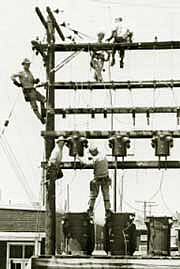Polychlorinated Biphenyl (PCB) Releases

Public Health Assessment
In 1942, the federal government established the Oak Ridge Reservation (ORR) as part of the Manhattan Project. The Y-12 plant, the K-25 site, and the S-50 site were created to enrich uranium. The X-10 site was developed to manufacture and separate plutonium. Uranium and plutonium isotope production, as well as other machining operations, required a large amount of electrical energy that used polychlorinated biphenyls (PCBs). During these operations and former waste disposal practices, oily PCB fluids were spilled onto the ground and released into nearby creeks and ponds.
The Agency for Toxic Substances and Disease Registry (ATSDR) conducted a public health assessment (November 2006) to evaluate whether past and current exposures to ORR-related PCBs in air, nearby off-site waterways (Clinch River, East Fork Poplar Creek, Poplar Creek, Lower Watts Bar Reservoir, and the Tennessee River), and biota (fish, geese, and turtles) could cause harm. ATSDR concluded that exposures to ORR-related PCBs in air and in these off-site waterways are not a public health hazard. Based on an in-depth public health evaluation, however, ATSDR determined that it would be prudent public health practice to minimize exposure to PCBs by limiting consumption of certain species of fish. Additionally, ATSDR recommends that certain sensitive populations (pregnant women, women who might become pregnant, nursing mothers, and children) avoid eating particular species of fish from these water bodies.
- All fish species are safe to eat in low amounts (up to one fish meal* per month).
- Sunfish are safe to eat in any amount.
- Largemouth bass are safe to eat in high amounts (three fish meals* per week) from Poplar Creek and the Lower Watts Bar Reservoir.
- Adults can safely eat three meals* of largemouth bass from the Clinch and Tennessee Rivers.
- Children can safely eat only one meal* of largemouth bass per week from the Clinch River and two meals* of largemouth bass per week from the Tennessee River.
- Catfish, striped bass, white bass, and hybrid (striped bass-white bass) bass are safe to eat in low amounts from Poplar Creek, the Clinch River, the Tennessee River, and the Lower Watts Bar Reservoir.
- Adults can safely eat one meal* per week of any of these fish.
- Children can safely eat one meal* per month of any of these fish.
- Canada goose muscle is safe to eat in any amount.
- Turtle meat is safe to eat in any amount, but no one should eat turtle fat, turtle eggs, and turtle organs.
*One adult fish meal is considered to be 8 ounces (1/2 pound). Children were assumed to eat one-third as much as adults.
Contact Us:
- Agency for Toxic Substances and Disease Registry
4770 Buford Hwy NE
Atlanta, GA 30341-3717 USA - 800-CDC-INFO
(800-232-4636)
TTY: (888) 232-6348
Email CDC-INFO - New Hours of Operation
8am-8pm ET/Monday-Friday
Closed Holidays


